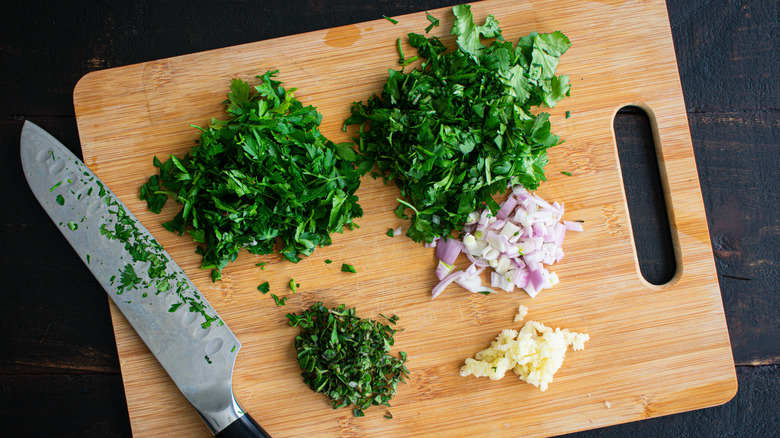Gordon Ramsay's Tips For Chopping Herbs And Preserving Flavor
Many dishes are only as good as their seasonings. Have you ever eaten a chicken breast that, while well-prepared, was about as flavorful as a piece of unbuttered popcorn? If a little salt and pepper can do wonders, introducing herbs to your dish can be a total game-changer. But, since flavor is the goal here, it's important to make sure your herbs retain their natural taste from the cutting board to the stockpot. Depending on how you're chopping herbs, that flavor might be getting lost along the way.
Luckily, there's a world-renowned chef with tips on how to avoid this very problem. Gordon Ramsay's first self-owned establishment, the aptly-named Restaurant Gordon Ramsay, received three Michelin stars shortly after its opening. Ramsay is one of only four chefs in the U.K. to be awarded three Michelin stars and his self-named restaurant is the longest-running three-starred dining establishment in London (per Gordon Ramsay). He also holds four collective stars at his other restaurants across Europe. This is a chef who can definitely tell you how to chop an herb.
On one of his cooking shows, Culinary Genius, Gordon Ramsay demonstrates for the contestants his technique for chopping herbs while preserving flavors. The biggest tip for preserving flavors as you chop herbs is all about what Gordon Ramsay calls, "The Three Finger Rule" and here's how to do it.
Let the knife do the work
To put the "Three Finger Rule" in action, guide the knife by placing one finger in front of your herb bundle and two fingers behind. By anchoring your hand on the cutting board this way, your knuckles will protect your hand from the moving blade as you cut. Plus, this position allows you to put the pressure into your fingers instead of pressing down on your herbs and squishing them (per Masterclass). Per Ramsay's demonstration video, he says to lightly "pinch" the base of the knife to the cutting board as you chop your herbs. This provides the smallest, finest mince, and also prevents the flavor of the herbs from getting pressed into your cutting board (and leaving behind an unsightly stain). Ramsay demonstrates this technique using chives, but any long, thin herb can benefit from chopping this way.
For leaf-shaped herbs, like basil, Ramsay suggests a different technique. Gather the leaves into a stack, he says, then roll them in the same way you might roll a cigar. Take care not to bruise the leaves as you roll. Then, using the same knife and hand placement technique as before, slice the leaves into thin strips by "let[ting] the knife do the work," as Ramsay says during his demonstration video. Using these tips, the herb's natural flavors are preserved and can end up in your dish instead of in your cookware.

